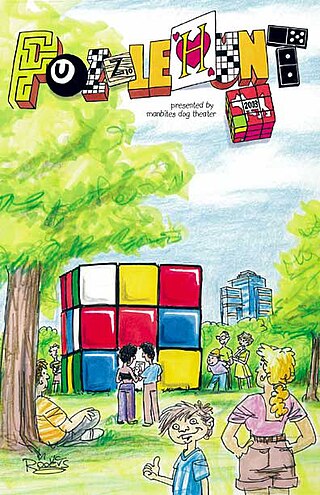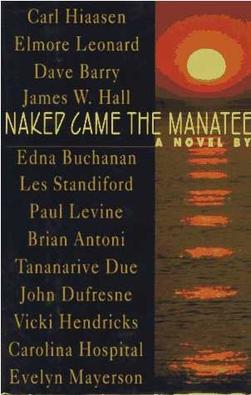Related Research Articles

The Bermuda Triangle, also known as the Devil's Triangle, is an urban legend focused on a loosely defined region in the western part of the North Atlantic Ocean where a number of aircraft and ships are said to have disappeared under mysterious circumstances. The idea of the area as uniquely prone to disappearances arose in the mid-20th century, but most reputable sources dismiss the idea that there is any mystery.

David McAlister Barry is an American author and columnist who wrote a nationally syndicated humor column for the Miami Herald from 1983 to 2005. He has also written numerous books of humor and parody, as well as comic novels and children's novels. Barry's honors include the Pulitzer Prize for Commentary (1988) and the Walter Cronkite Award for Excellence in Journalism (2005).

A crossword is a word game consisting of a grid of black and white squares, into which solvers enter words or phrases ("entries") crossing each other horizontally ("across") and vertically ("down") according to a set of clues. Each white square is typically filled with one letter, while the black squares are used to separate entries. The first white square in each entry is typically numbered to correspond to its clue.

A cryptic crossword is a crossword puzzle in which each clue is a word puzzle. Cryptic crosswords are particularly popular in the United Kingdom, where they originated, as well as Ireland, the Netherlands, and in several Commonwealth nations, including Australia, Canada, India, Kenya, Malta, New Zealand, and South Africa. Compilers of cryptic crosswords are commonly called setters in the UK and constructors in the US. Particularly in the UK, a distinction may be made between cryptics and quick crosswords, and sometimes two sets of clues are given for a single puzzle grid.
The MIT Mystery Hunt is an annual puzzlehunt competition at the Massachusetts Institute of Technology in Cambridge, Massachusetts. It is one of the oldest and most complex puzzlehunts in the world and attracts roughly 120 teams and 3,000 contestants annually in teams of 5 to 150 people. It has inspired similar competitions at Microsoft, Stanford University, Melbourne University, University of South Carolina, University of Illinois at Urbana–Champaign and University of Aveiro (Portugal) as well as in the Seattle, San Francisco, Miami, Washington, D.C., Indianapolis and Columbus, Ohio metropolitan areas. Because the puzzle solutions often require knowledge of esoteric and eclectic topics, the hunt is sometimes used to exemplify popular stereotypes of MIT students.

Gene Norman Weingarten is an American journalist, and former syndicated humor columnist for The Washington Post. He is the only two-time winner of the Pulitzer Prize for Feature Writing. Weingarten is known for both his serious and humorous work. Through September 2021, Weingarten's column, "Below the Beltway," was published weekly in The Washington Post magazine and syndicated nationally by The Washington Post Writers Group. Weingarten also writes Barney & Clyde, a comic strip with illustrations by David Clark.

A scavenger hunt is a game in which the organizers prepare a list defining specific items, which the participants seek to gather or complete all items on the list, usually without purchasing them. Usually participants work in small teams, although the rules may allow individuals to participate. The goal is to be the first to complete the list or to complete the most items on that list. In variations of the game, players take photographs of listed items or be challenged to complete the tasks on the list in the most creative manner. A treasure hunt is another name for the game, but it may involve following a series of clues to find objects or a single prize in a particular order.
Perplex City was an alternate reality game (ARG) created by Mind Candy, a London-based developer in 2005. Adrian Hon was the producer, designer and director of the game's first and only season, in which players searched for "The Receda Cube", an artifact of spiritual significance to the inhabitants of a fictional metropolis known as "Perplex City" which had great scientific value. In the game, "The Cube" had been stolen and buried somewhere on Earth.

A puzzle hunt is an event where teams compete to solve a series of puzzles, many of which are tied together via metapuzzles. Puzzlehunt puzzles are usually not accompanied by direct instructions for how to solve them; figuring out the necessary approach is part of the puzzle. These hunts may be hosted at a particular location, in multiple locations, or via the internet.

An acrostic is a type of word puzzle, related somewhat to crossword puzzles, that uses an acrostic form. It typically consists of two parts. The first part is a set of lettered clues, each of which has numbered blanks representing the letters of the answer. The second part is a long series of numbered blanks and spaces, representing a quotation or other text, into which the answers for the clues fit. In some forms of the puzzle, the first letters of each correct clue answer, read in order from clue A on down the list, will spell out the author of the quote and the title of the work it is taken from; this can be used as an additional solving aid.
Eric Shansby commonly known as Shansby, is an American cartoonist and children's book illustrator. His cartoons appear in American news outlets, most prominently in The Washington Post alongside columns by humorist Gene Weingarten.

Merv Griffin's Crosswords is an American game show based on crossword puzzles. The show was created by its namesake, Merv Griffin, who died shortly after beginning production on the series. Ty Treadway was the host, and Edd Hall was the announcer.

Naked Came the Manatee (ISBN 978-0399141928) is a mystery thriller parody novel published in 1996. It is composed of thirteen chapters, each written by a different Miami-area writer. It was originally published as a serial in the Miami Herald'sTropic magazine, one chapter per issue, and later published as a single novel. Its title is a reference to the literary hoax Naked Came the Stranger. The book was conceived of and edited by Tom Shroder, then editor of Tropic. Dave Barry came up with the first chapter, which was then handed to the next writer, and so on until Carl Hiaasen had to tie all the loose threads together in the final chapter. Each chapter was written on deadline for publication in the magazine.
The Post Hunt was an annual puzzlehunt in Washington, DC. It was co-created by Miami Herald columnist Dave Barry, along with Gene Weingarten and Tom Shroder. The Post Hunt debuted in 2008. The most recent hunt took place on May 22, 2016. The hunt was discontinued in 2017. It was a renamed version of the Tropic Hunt, also created by Barry, Weingarten and Shroder, which had a long run in Miami, FL.

On The Trail Of The Golden Owl is a French armchair treasure hunt book created by communications expert Régis Hauser under the pseudonym "Max Valentin" and illustrated by artist Michel Becker. The book was first published in 1993. It provides clues to the location of a buried statuette of an owl, created by Becker.
Barney & Clyde is a daily newspaper comic strip created by Washington Post columnist Gene Weingarten, his son Dan Weingarten, and cartoonist David Clark. Originally syndicated by The Washington Post Writers Group, it debuted on June 7, 2010. Barney & Clyde appears in The Washington Post, The Miami Herald, The Detroit Free Press and many other newspapers.
Tom Shroder is an American journalist, writer and editor who worked for the Washington Post for many years.

Tropic was the Miami Herald's Sunday magazine, published as an insert in the Sunday edition from 1967 until 1998. Tropic won three Pulitzer Prizes and published many writers who went on to become well known. More notable writers included humor columnists Dave Barry, Gene Weingarten, Carl Hiaasen, and Madeleine Blais. Other writers included Paul Levine, Joel Achenbach, Tom Shroder, and others.

Lollapuzzoola is a crossword-solving tournament held annually on a Saturday in August. Founded in 2008 by Brian Cimmet and Ryan Hecht, it is the second-largest crossword tournament in the United States, and the only major tournament in New York City. The term "Lollapuzzoola" was coined by Amanda Yesnowitz, as a play on the Lollapalooza music festival. Lollapuzzoola 16 took place on August 19, 2023, and was cohosted by Brian Cimmet, Brooke Husic, and Sid Sivakumar.

The Lost Island of Alanna is a branded, graphic adventure video game and marketing initiative conceived and directed by Dale Leary and developed with partner Michael Hall of Raintree Media for Coca-Cola Cherry. The game was produced for the brand in the Fall of 1997 and released in the Spring of 1998.
References
- ↑ Silman, Jon. "Difficult 2011 Herald Hunt stumps thousands". Miami Herald . Retrieved 2012-04-30.
- ↑ Wenzel, Andy. "The Tropic Hunt Archives: The 1998 Hunt". Archived from the original on 2008-05-23. Retrieved 2008-08-10.
- ↑ Wenzel, Andy. "The Tropic Hunt Archives" . Retrieved 2008-08-10.
- ↑ Engelberg, Mark. "Winning the Herald Hunt". Archived from the original on 2011-07-14. Retrieved 2008-08-10.
- ↑ Smiley, David (2007-10-22). "For Herald Hunt winners, 17th try is the charm". Miami Herald. Retrieved 2008-08-10.[ dead link ]
- ↑ Weingarten, Gene; Shroder, Tom (2008-05-19). "Post Hunt: The Aftermath". Chat Transcript. Washington Post. Retrieved 2008-08-10.
- ↑ The Washington Post Magazine. "2009 Post Hunt" . Retrieved 2009-05-19.
- ↑ "For Post Hunt players, more wild mind trips" Washington Post, June 7, 2010. p. C3